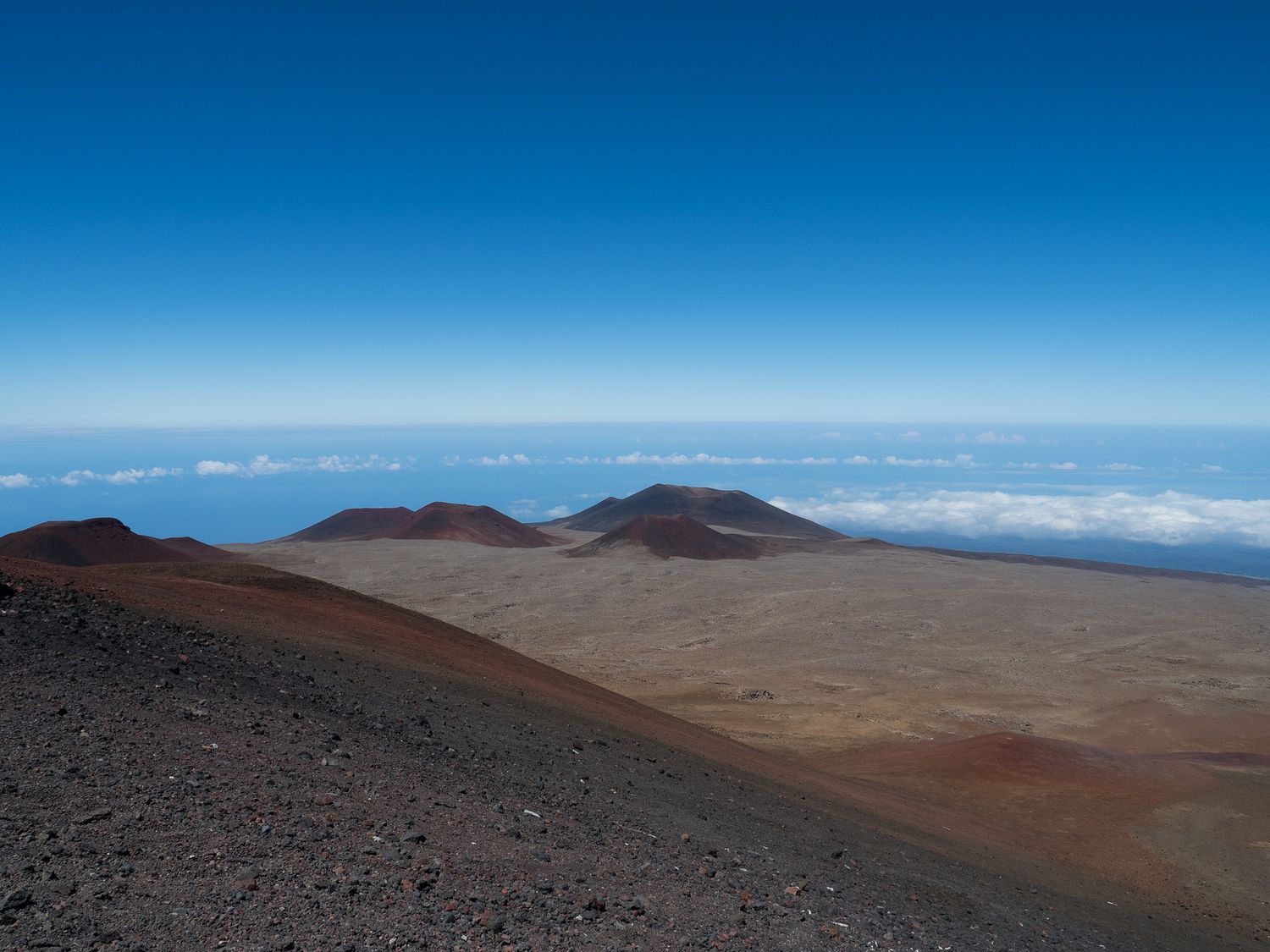– Big Island, Hawaii –
It’s our last big day in Hawaii. Tomorrow morning we get up and fly back to Honolulu, then get on a big plane to take us all the way back to DFW. It’s been a lot of fun, but I’m ready to go home. I really miss little Ripley, and sleeping in my own bed. I also miss sleeping in general. This vacation thing is hard work.
When we woke up this morning, it was raining outside of our Bed and Breakfast, and while it is only 6 or 8 miles into Hawaii Volcanoes National Park, where we’d planned to run, we were sort of hoping that the rain might not be falling over there. The climate here shifts dramatically in a matter of minutes, so we thought we might get lucky and see sunshine once we made it into the park.
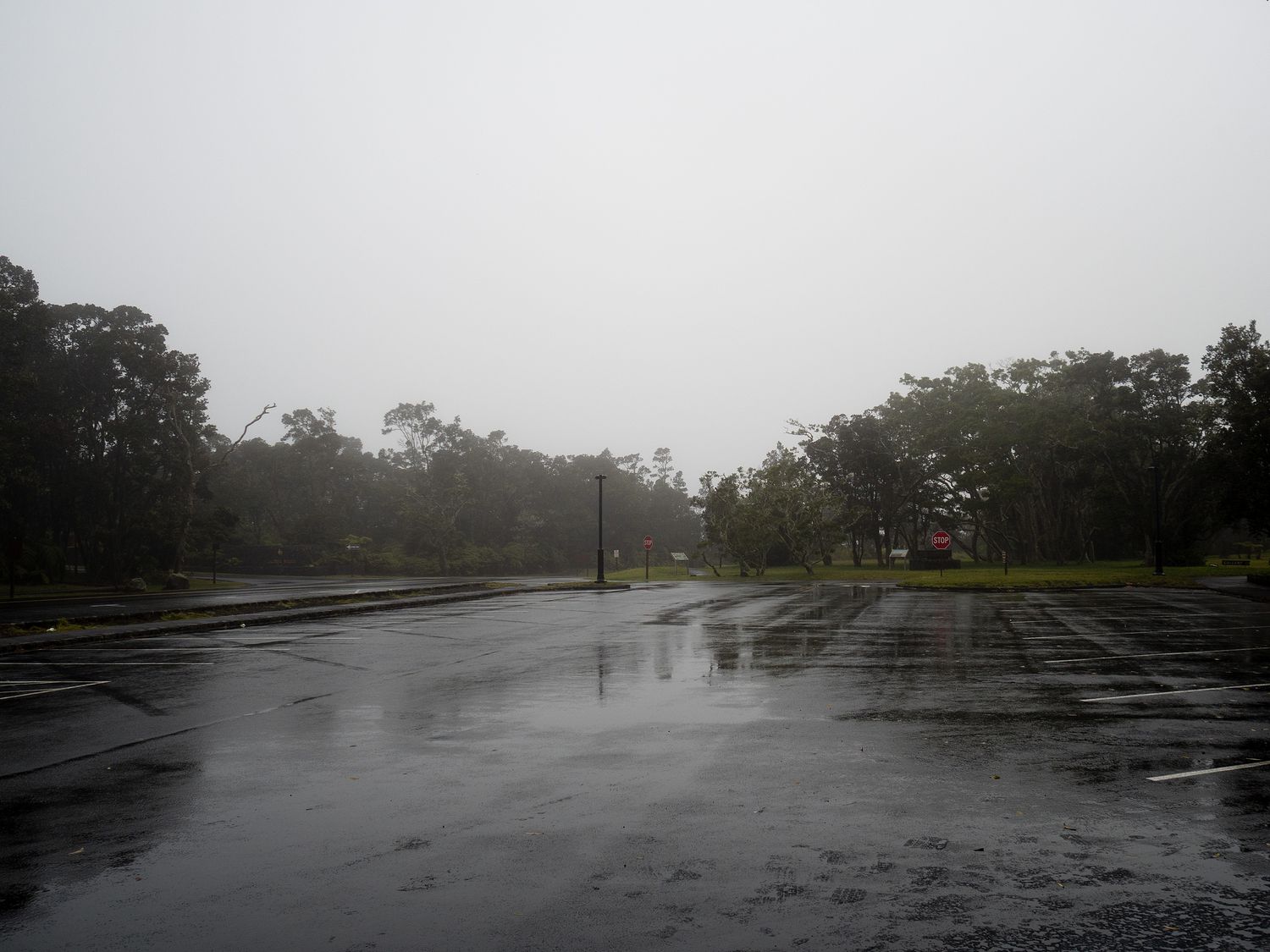
Unfortunately, that wasn’t the case. It was still spitting rain, but in the end, we decided that it wasn’t particularly cold in the rain, and we didn’t mind getting wet in our running clothes too much, so we decided to go for it. The rain also meant that we couldn’t see the volcano crater like we thought we might be able to. We were hoping to see the red glow of the lava flowing from it that we’ve heard is best to see when it’s dark, since it was so early in the morning. It ended up being too foggy for the most part, though Mark said he saw it a little while we were out.
We ended up running about 3.5 miles along the park’s crater rim trails, then went back to our Jeep. We were soaking wet when we finished, with water dripping off of our running hats and down our legs. Since we’d brought our swimsuits, as the plan was to drive down to a black sand beach a little ways down the coast immediately after our run, we changed into those to get dry. It was a nice change.
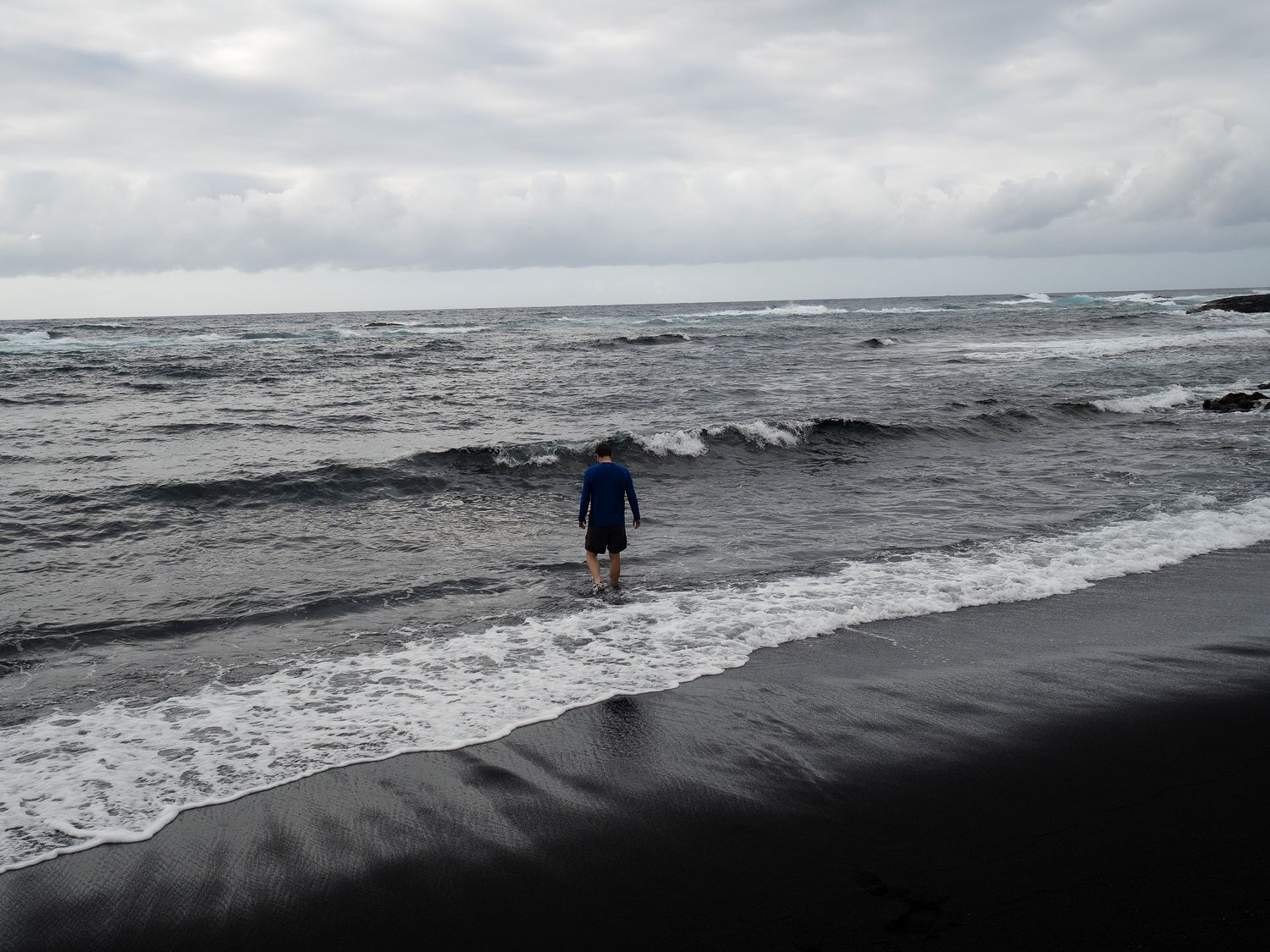
With our running stuff spread out all over the back of our Jeep to dry, we made our way about 40 minutes back down the road towards South Point to stop at Punalu’u Beach, which is one of Hawaii’s most famous black sand beaches. I should mention- it stopped raining just outside of the national park. Go figure. The sun was even out.
The black sand beach is also famous for its sea turtles, though we didn’t know that part before we went. In fact, we just went to see the sand and go for a swim. Instead, upon arrival, I spotted a turtle’s head a little ways out in the water and pointed it out to Mark. A few minutes later, I found a sign about all of the turtles on the beach, warning us not to bother them, feed them, or attempt to ride them, which I can promise you would never have occurred to me.
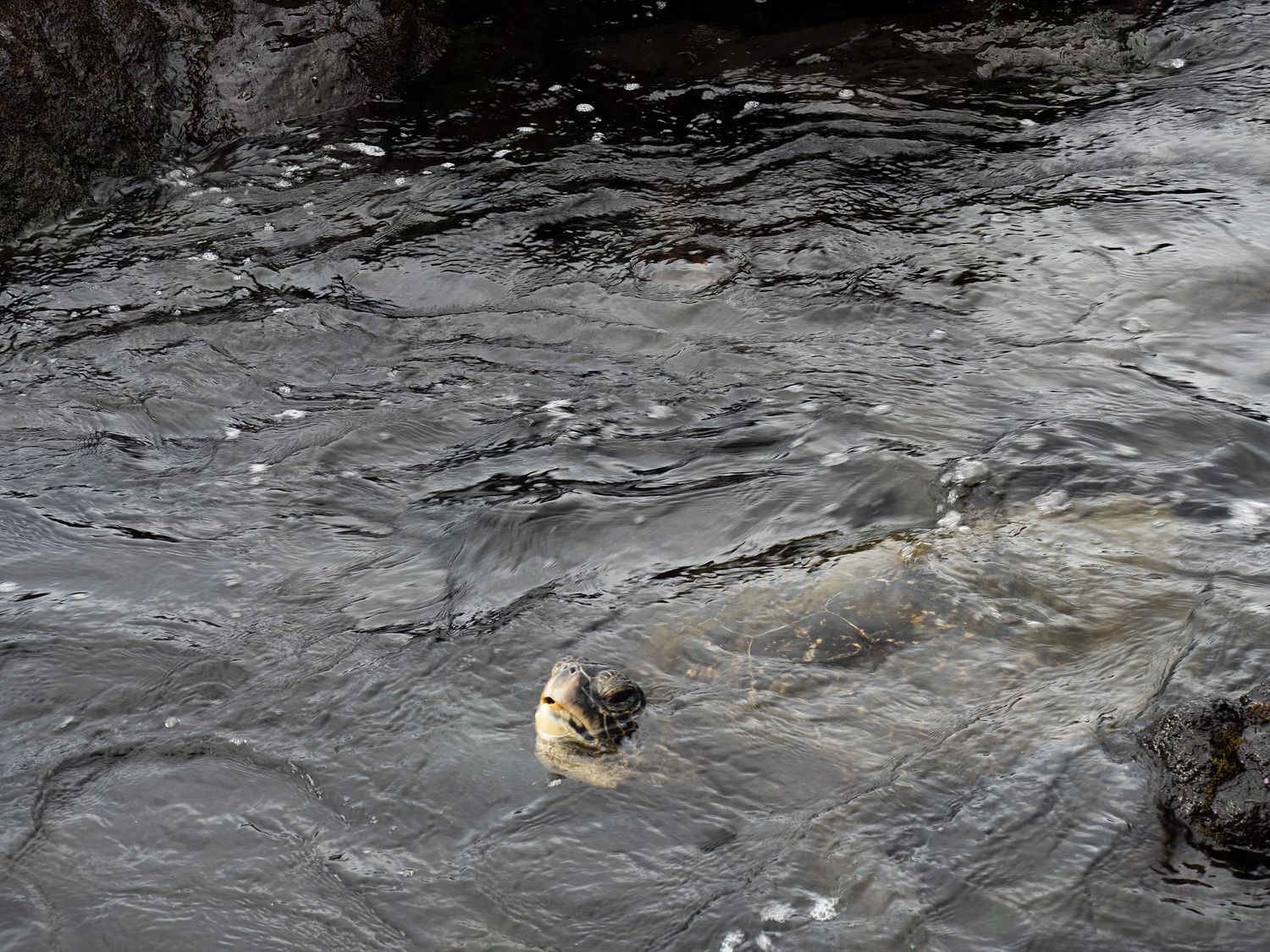
Mark went out into the water first while I wandered around on the beach. I found a set of drag marks where a turtle had dragged itself up on the beach when I suddenly saw Mark having a minor panic attack out in the water. It turns out that a turtle had come up right beside him, which freaked him out and he was desperately trying to get away. I’m pretty sure he thought it was going to eat him.
Once he’d calmed down, we put the camera back in the Jeep for a while so we could both go into the ocean. The bottom of Punalu’u Beach is made up of very large rocks, and the surf is very rough. You sort of have to float out into the water, rather than making an attempt to walk. Mark learned that the hard way when he was trying to walk out the first time, as he ended up scraping up his ankle. The water is very cold, but it has pockets of warmth that are sort of oddly mixed in. You can be standing in bathwater warm water one minute, then turned to ice in another when a new wave rolls in. It’s a strange feeling.
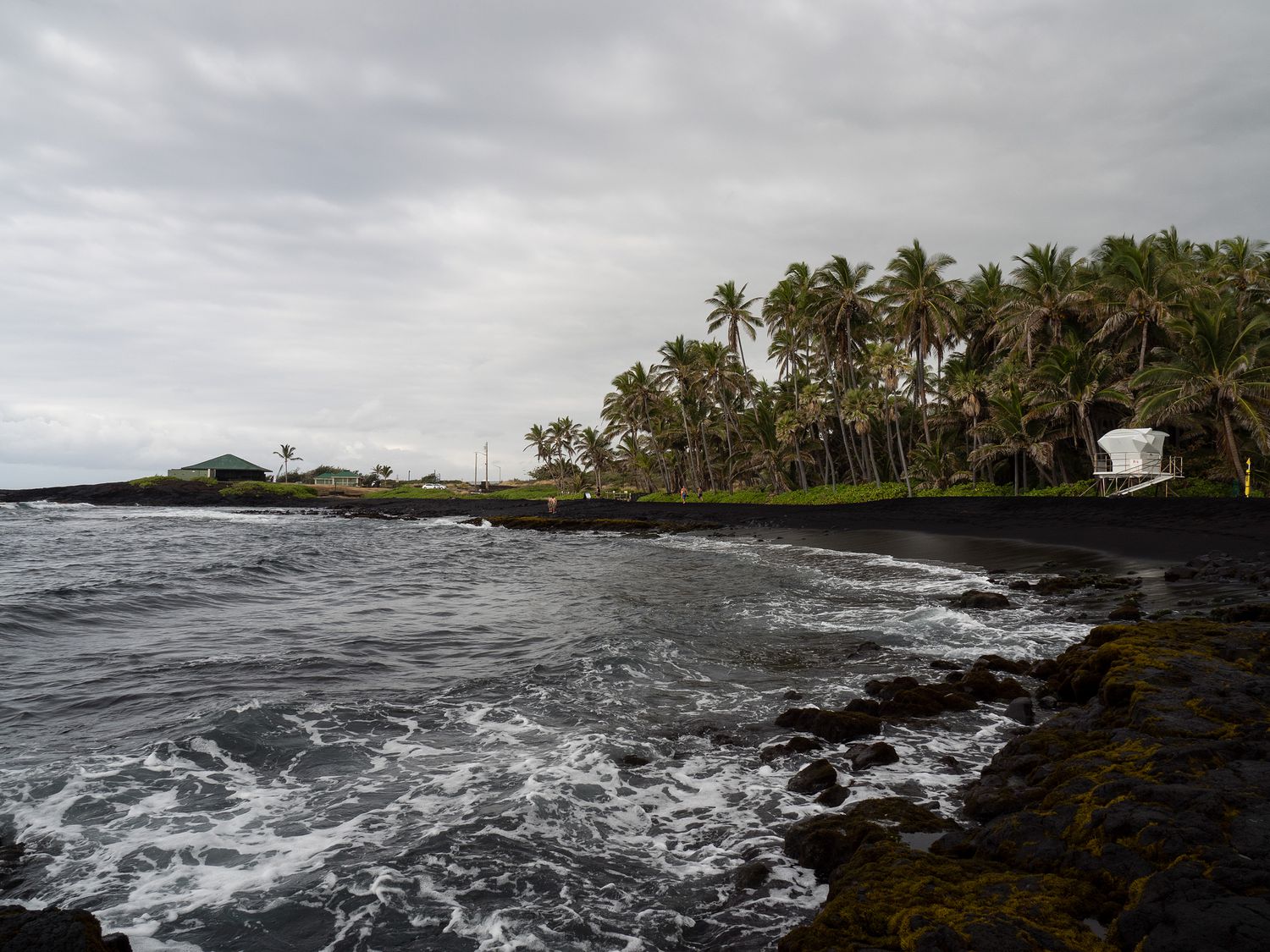
We eventually emerged from the water and toweled off. At this point, we still hadn’t seen a turtle clearly, though Mark had his close encounter and we had seen several in the distance while we were swimming. While we were standing on the beach, we noticed a couple of people clustered around a little rocky nook on the beach, so we walked over to see what they were looking at.
There was a sea turtle in a small pool there amongst the rocks, eating something on the rocks themselves. I’m not sure what was so good, but he was happily munching away while we all stood around and took pictures. I wonder if he could even see us, or if we just didn’t matter to him.
I’ve seen turtles in the zoo and the aquarium before, of course, but it is really something else to see them in the wild. I was just floored, and every time he stuck his little head out of the water, I was surprised and thrilled. You feel silly afterwards, but in the moment it is very exciting.
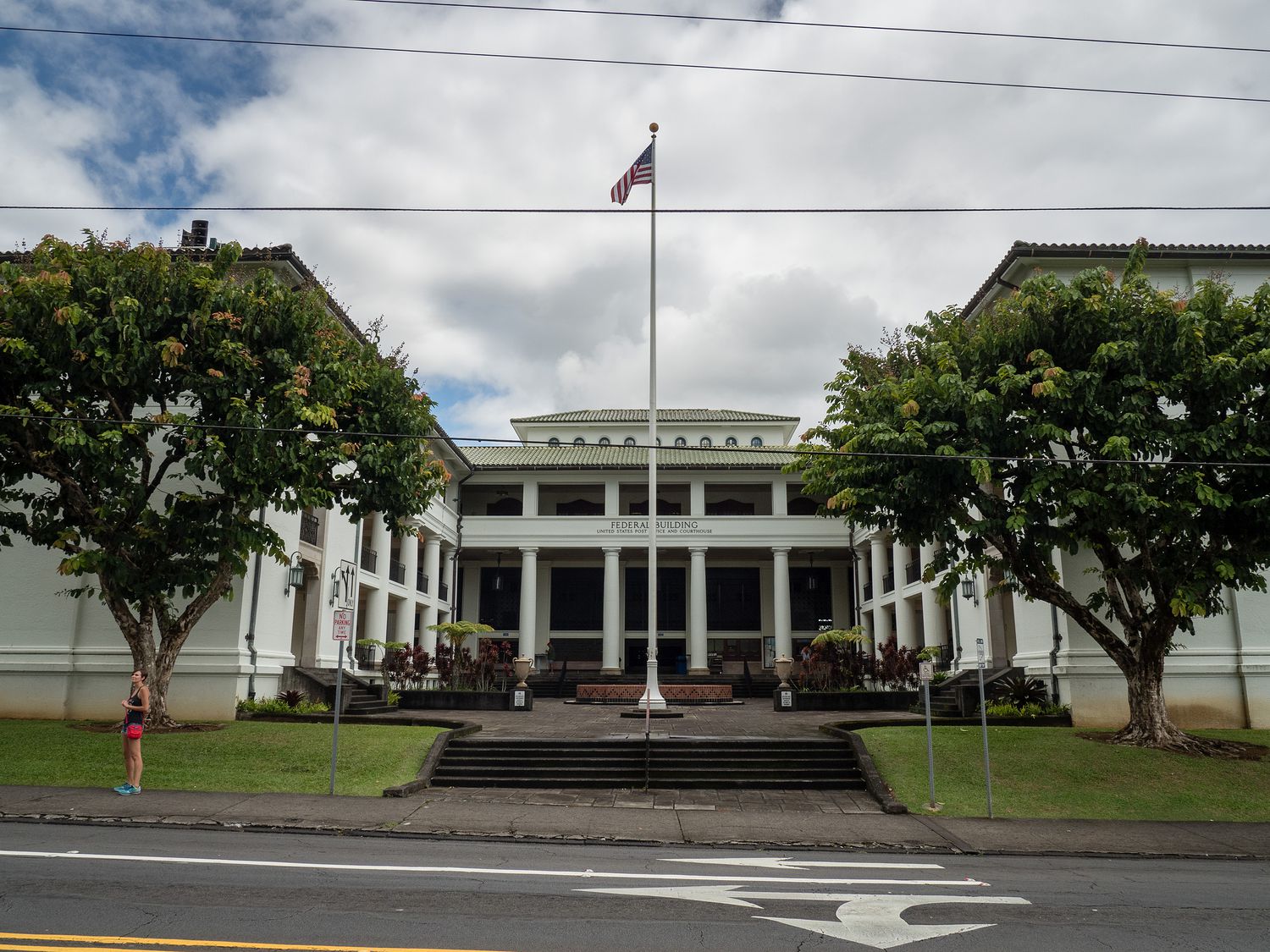
With our swim finished and many turtle photos to take home, we drove back to our hotel. There we showered and had leftover pizza from last night for our breakfast. We were a bit leisurely about leaving, so while we were back here by about 8:30, we didn’t leave until after 9:30, I think.
We drove the half hour into Hilo to run a few errands, including getting gas and picking up some McDonald’s teas. We also went in search of local courthouse buildings for Mark to photograph for his collection, though they are really difficult to figure out here in Hawaii. In that same area, we found the post office, too, where we mailed a post card off and looked around.
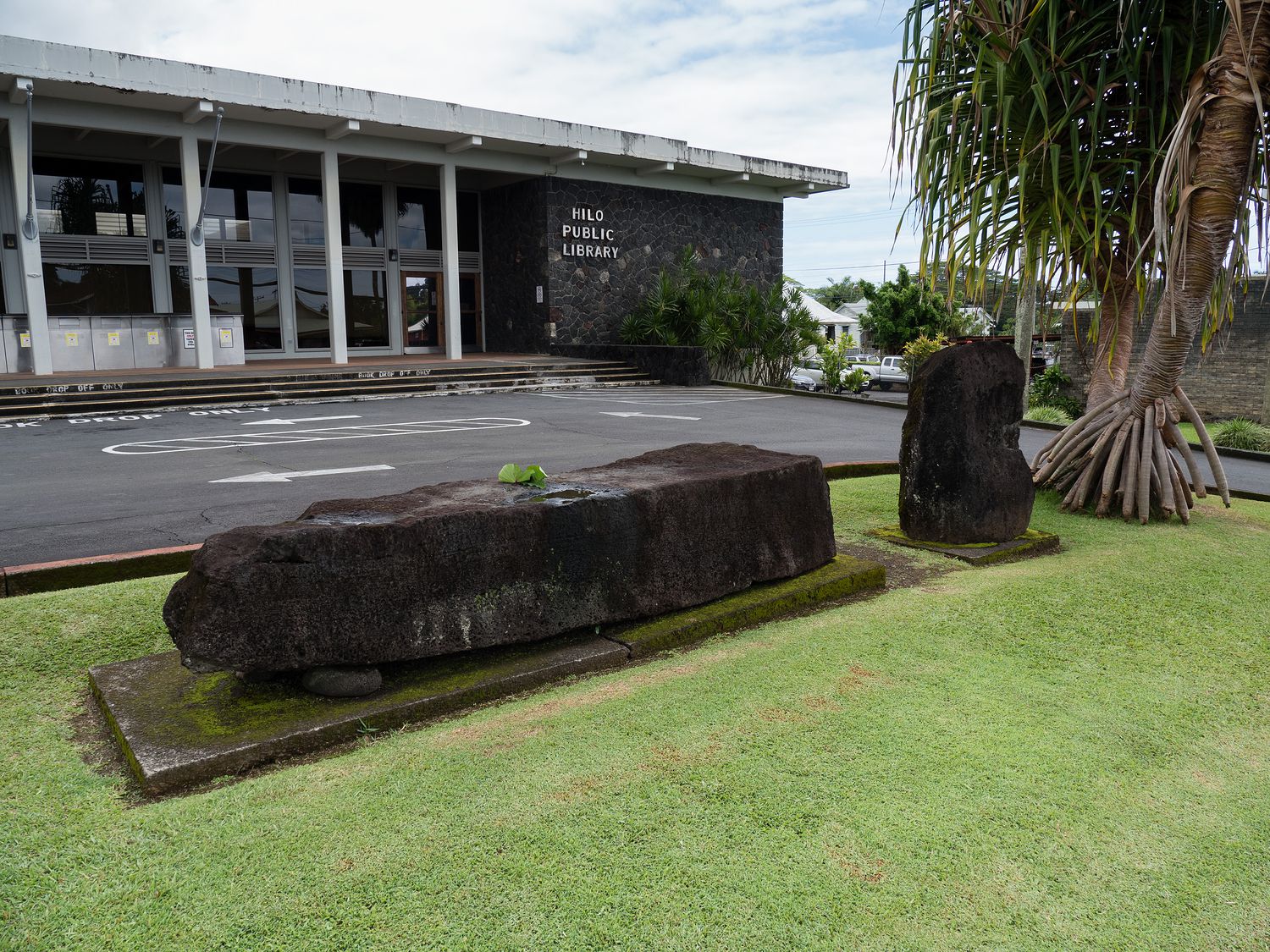
Yesterday, at Pu’ukohola Heiau National Historic Site, we read about a huge rock called the Naha Stone, which is a volcanic rock that has historically been used in many of the cultural traditions of the native Hawaiians. In particular, we read the legend that the king that united the Hawaiian islands, Kamehameha I, lifted the stone when he was about 14, thus proving that he was the prophesied leader to unite the islands. It’s supposed to weigh about 5,000 pounds, so I’m skeptical unless he was the first guy to think of using a lever and a counterweight or something.
Anyway, we decided to walk over and see it, since we were close. It’s set up outside of Hilo Public Library. I tried to get Mark to make like he was lifting it for a picture, but he just stood beside it instead, the spoilsport.
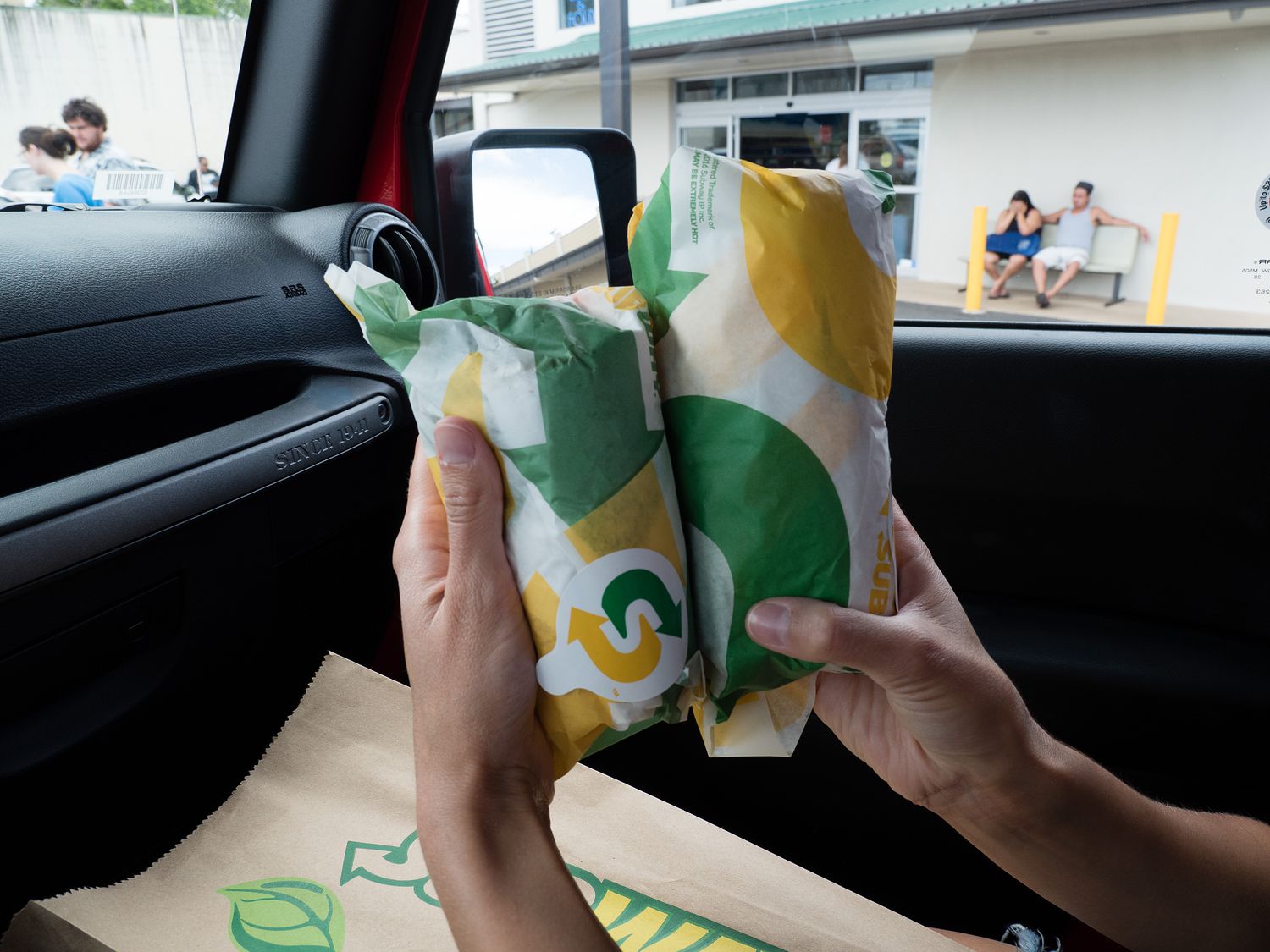
It was about 11:30 by now, since we’d done so much piddling around in Hilo, so we decided to go ahead and grab a light lunch. We gave in to simplicity and got sandwiches from Subway. Since we eat the same things, we always get a foot long veggie and split it. As you can see from the picture above, the guy that was fixing it didn’t seem to care much for his job. It was hilariously unevenly cut, and wrapped so poorly that food was sticking out. Like your job or not, Subway guy, you have to do it. Ugh.
Not long after noon, we left Hilo behind and took the Saddle Road once again over to the summit trail for Mauna Kea, which I believe I mentioned yesterday is considered the tallest mountain in the world if you measure from the sea floor. It measures over 33,000 feet from it’s base that way. That seems a bit like cheating to me, so I’d still consider Everest the highest, but I guess it really depends on how you want to look at it. It’s definitely the highest point in the state of Hawaii at 13,796 feet, according to the map they gave us. The internet has a figure about 7 feet higher, but I’ll assume the mountain’s visitor center is right for now. As with all things Hawaii, surprise! it’s a volcano, though this one is dormant.
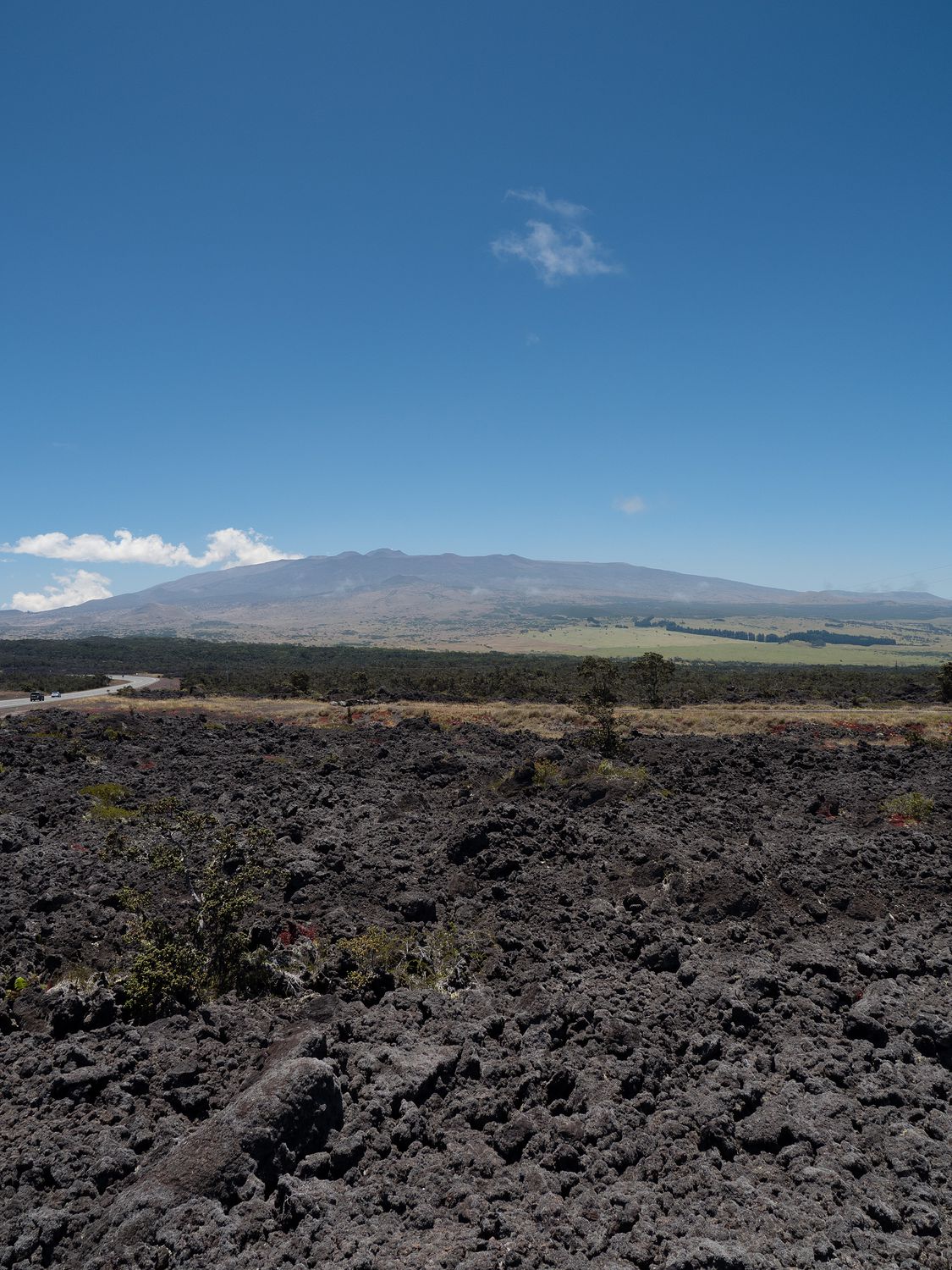
Up until today, we hadn’t actually seen the top of Mauna Kea, and on the drive in today, it just happened to be totally clear. In pictures, it doesn’t look that high, and I was a bit startled by the view from the road. It just doesn’t look as big as it is, perhaps because it is so flat and wide.
To get to Mauna Kea, you must first stop at its visitor center, which is at 9,000 feet and is 6 miles by road from the base of the mountain. The road here is a very gradual upward slope, and it doesn’t feel like you’ve climbed much at all when you finally get there, because that part goes so quickly.
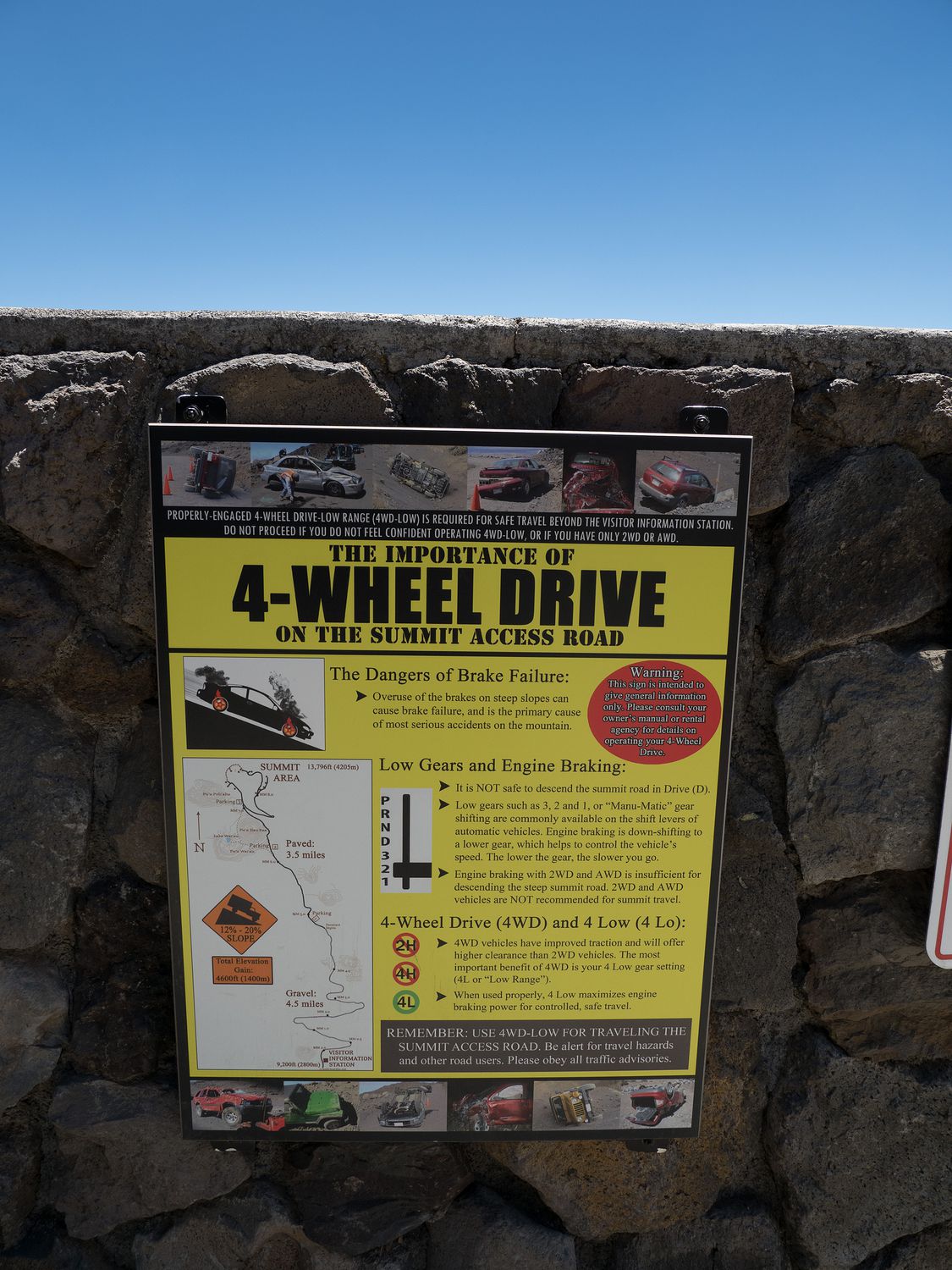
When you arrive at the visitor center, you get to learn about how dangerous the road up the mountain can be if you aren’t prepared. They strongly recommend that only 4WD vehicles ascend the mountain, and warn of brake and engine failure, among other things. You have to have at least half a tank of gas to get up there and back, and they warn that you really have to take your time. The grade ranges from 12-20%, which is much better than that scary road we saw the other day, so I guess it isn’t quite so bad.
If that weren’t enough, the ascent happens so rapidly that many people experience altitude sickness, so they recommend acclimating at the visitor center for a while. They also tell you not to go up the mountain if you: are under 16 years old, are pregnant or drunk, have been SCUBA diving in the last 24 hours or plan to in the next 24 hours, have just had surgery, or if you have high blood pressure, or any heart or respiratory conditions. They even kindly provide a list of the symptoms for some of the awful health issues you can have, like the altitude sickness, or the much worse High Altitude Pulmonary Edema and High Altitude Cerebral Edema.
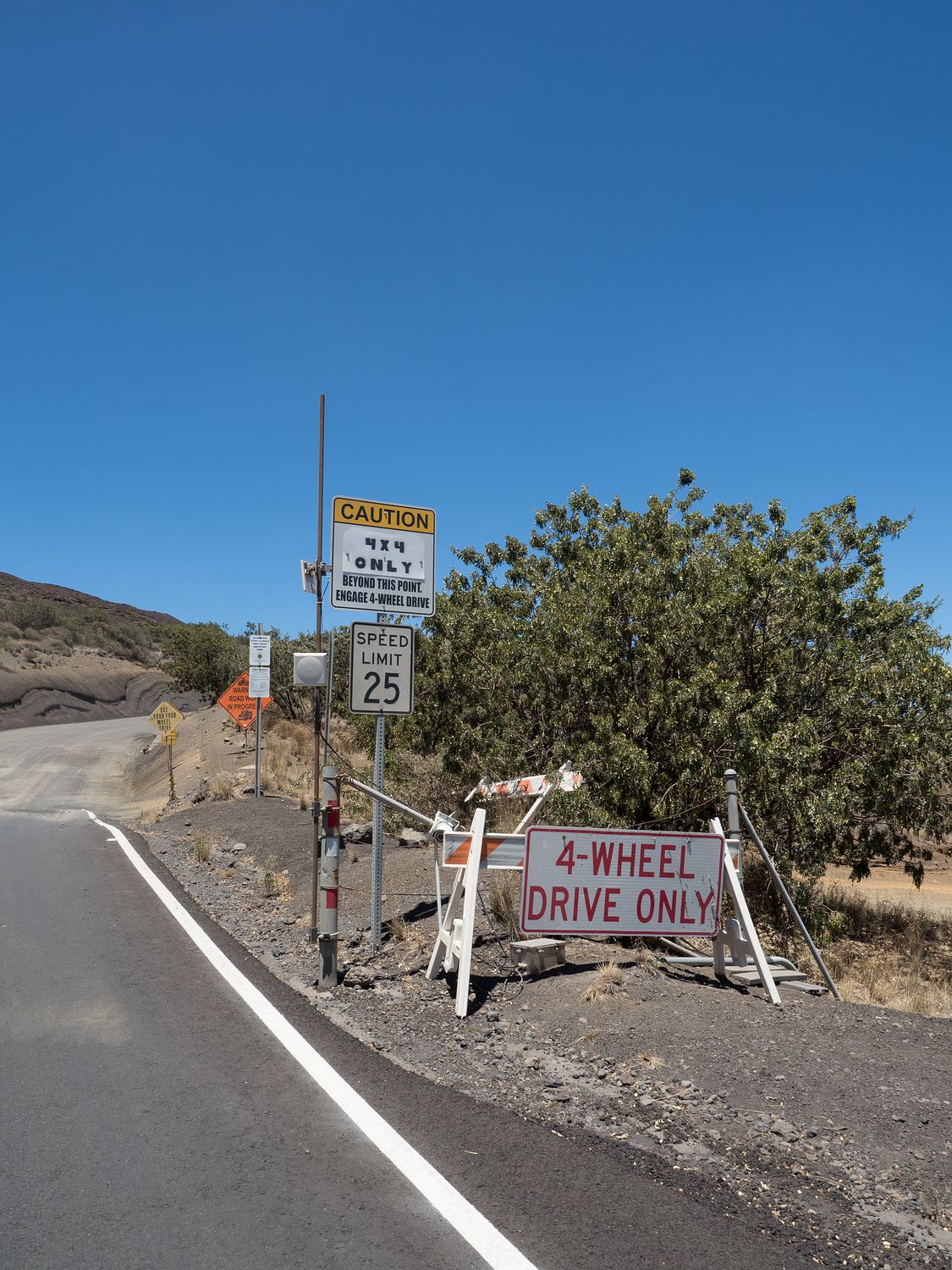
If that doesn’t freak you out a little, I don’t think you’re human. Regardless, we felt safe enough to go up to the top, as we are relatively healthy and were driving a good 4-wheel drive vehicle and had a decent driver. I suppose it won’t surprise you to hear that less than half of the people we saw at the visitor center seemed to making the drive up with us. I guess they just wanted to see the mountain.
After spending a little time acclimating at the visitor center, we bought Mark a T-shirt and a sticker, then hopped into the Jeep. This road is really why Mark wanted a Jeep on this island. He was so excited to go. I was a little more anxious than excited, but it didn’t turn out to be too bad to do at all. I read that people like to do it in the snow, too (yes, it snows in Hawaii). I would not have been up for that.
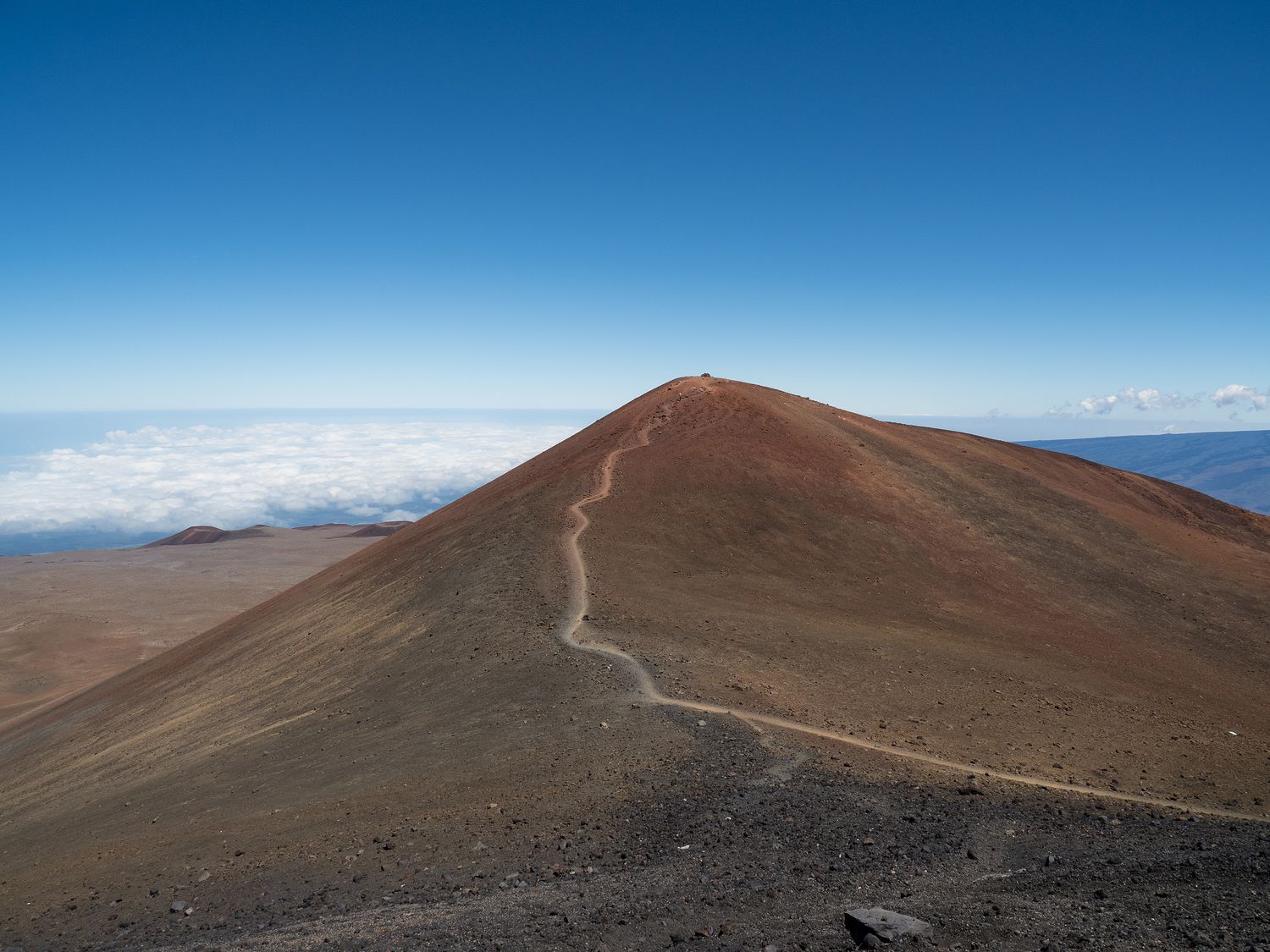
The first 4.5 miles of road up from the visitor center are washboard gravel, and the last 3.5 are paved again. We only saw four or five other cars on the trip, most of whom were going a little faster than us. I can’t tell if they were braver or stupider. It’s funny how often those look the same. Our Jeep handled it admirably on the way up in 4WD-Low, and we made it up much faster than I expected.
At the top of the mountain are 13 telescopes for various institutions from multiple countries around the world. The area is supposed to be one of the best in the world for astronomical work. It is definitely above the clouds, so I can see (in my very simple understanding) how it could be good. It’s also relatively isolated from light pollution. The internet tells me that there are a few other reasons, but I don’t think they are worth going into here.
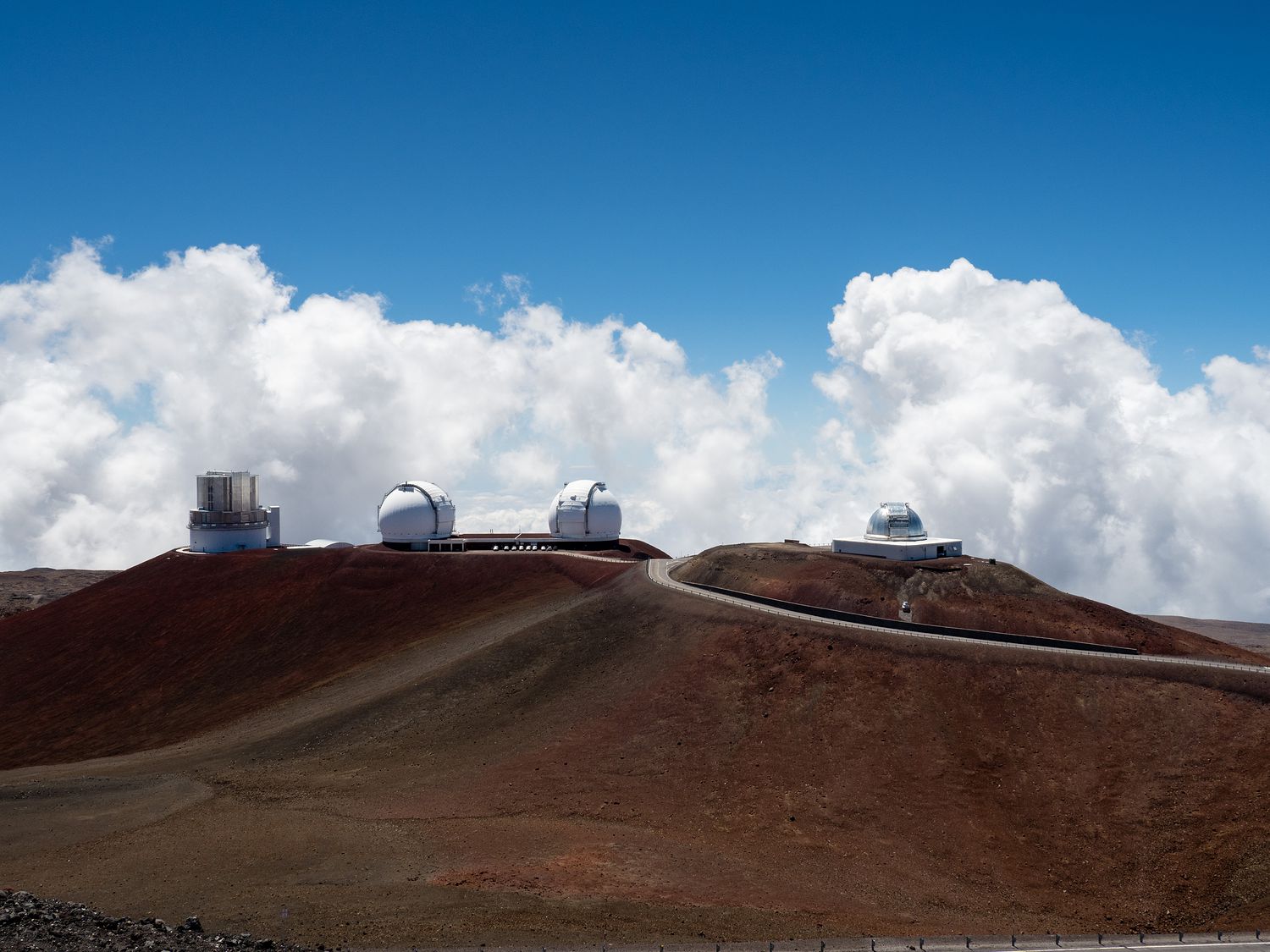
At the top of the mountain, we got out of the car at one of the observatories to look around. We could see the summit a little ways away from us, but elected not to attempt to climb it, because we were winded just walking down the road to take some photos. There’s very little air to be found over 13,000 feet, and we were not accustomed to it. Funnily enough, they were restoring one of the telescopes behind us, and we got to watch construction workers going about their day in the thin air without a problem. It’s all in what you’re used to, I guess.
We still made it to the top, as far as I am concerned. We were definitely as far up as you can get in a car, and perhaps only 50 feet short of the summit in height. It was also icy cold. Don’t get me wrong, the temperature was still 65 degrees, which is warmer than it was on Haleakala, but the wind is just insanely strong. I was scared to get close to the side of the road, not only because of the height, but because I was afraid the wind would blow me right off the side. Mark and I took a picture together to commemorate the occasion, and my hair is so crazy in the wind that I look like a mop.
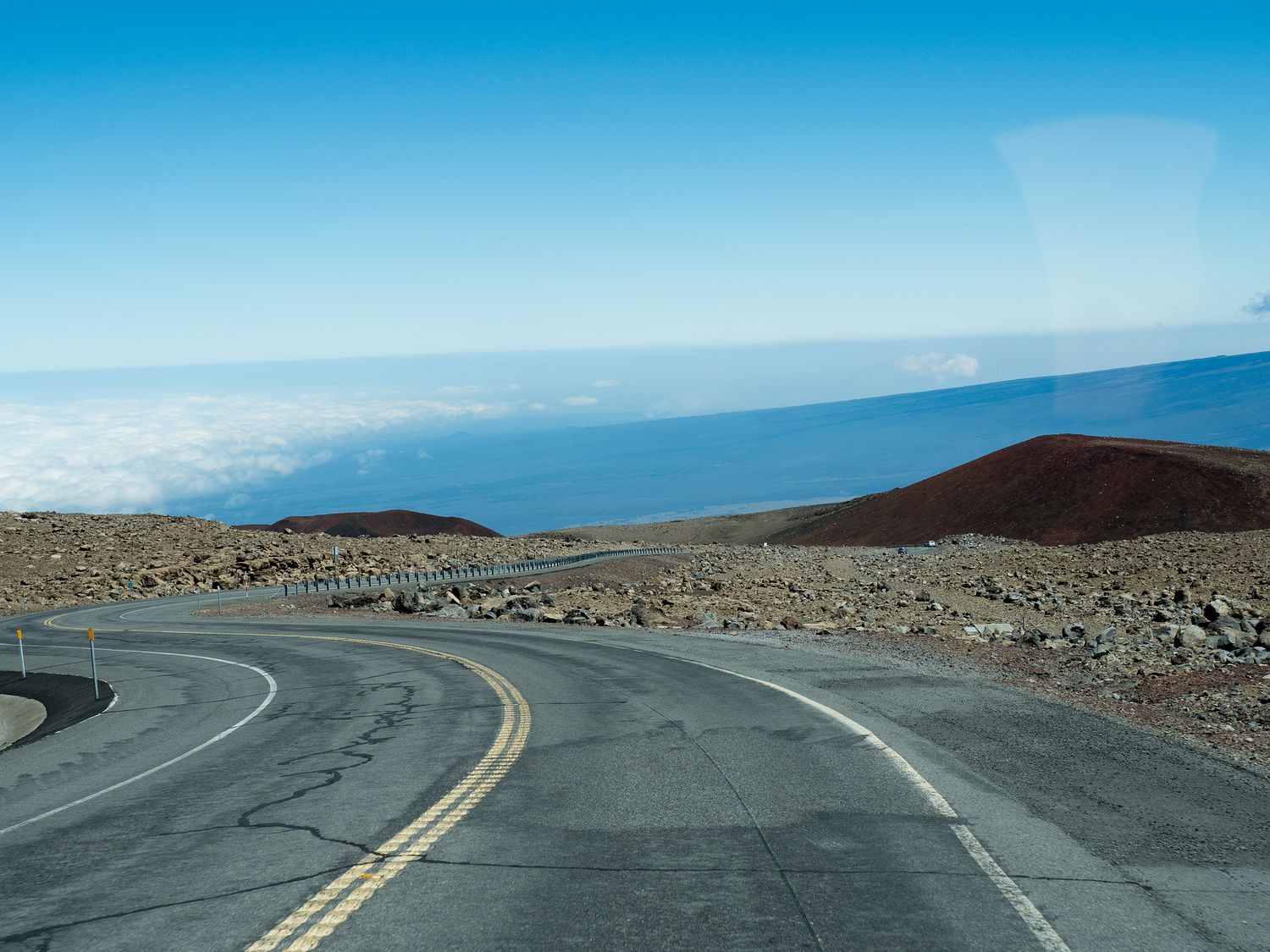
I found the road down a little scarier than the road up, which I think makes sense. The descent is more dangerous, and I’m not really used to the sounds engine braking makes, so every time the engine would throttle down, I would have a tiny heart attack and ask Mark if the Jeep was ok. He’s a saint for putting up with my fretting.
In all honesty, Mark had to hit the brakes very little, and while even at the time I knew intellectually that we were doing great, my instincts were screaming that our Jeep was going to break and we were somehow going to sail off of the mountain and die. Like I said, looking back, I don’t think it was worth the concern, but in the moment it was hard to let go.
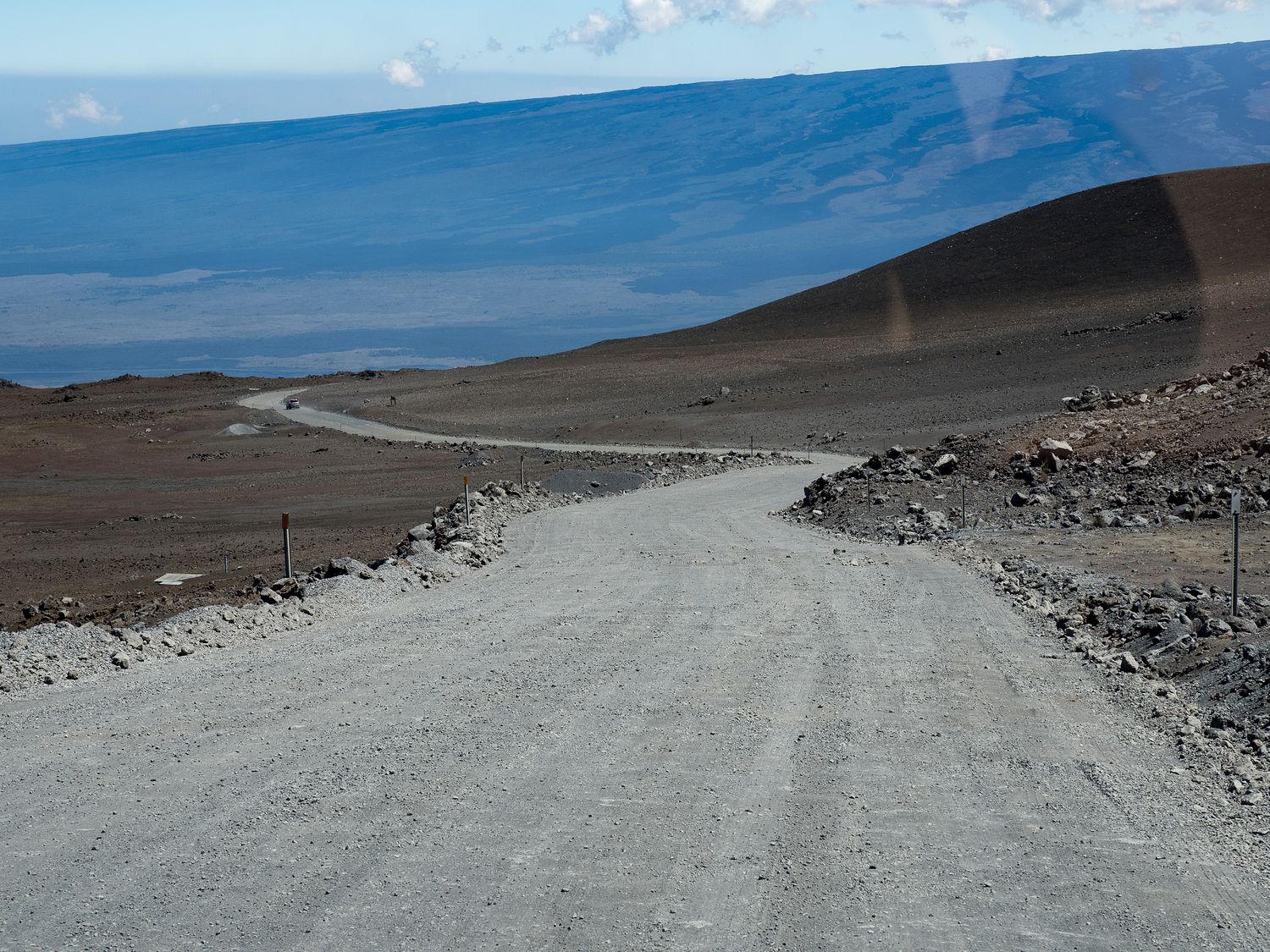
In the end, it took us only about 1.5 to 2 hours to do the whole thing, and no one got altitude sickness or sailed off the mountain. In fact, we saw a tiny car going up, along with an all-wheel drive, both of which were not supposed to attempt the summit, and they actually seemed to be doing fine. I can’t say how their cars were at the bottom, but I guess they didn’t think it was bad enough that you needed a 4-wheel drive. For us, it was definitely better safe than sorry.
It was around 3pm when we rolled back into Hilo after our visit to the mountain, and we restocked on tea before turning down our final section of the Big Island that we had yet to traverse. The area is just a tiny triangle on the bottom eastern side of the island, but we had some time and we’d yet to go.
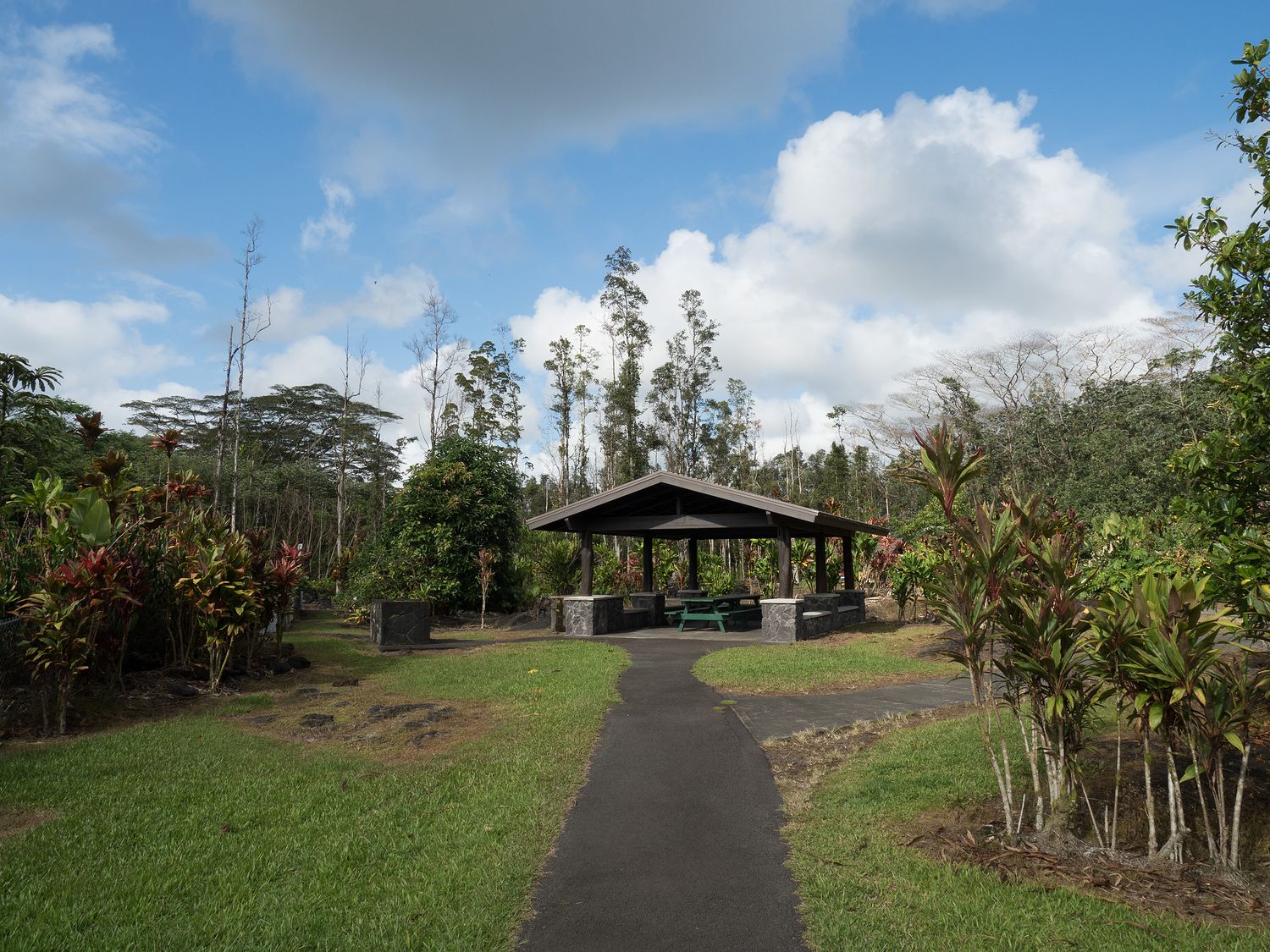
Out that way, there’s a little park called Lava Tree State Monument, which was on our list of sights on see on the Big Island. We stopped by there first, and were glad we did. A lava tree is a a small tower of volcanic rock that was formed when a forest was engulfed by a sudden rapid lava flow. This particular area was formed in the 1790s. A thin layer of lava cooled around the base of the tree trunks, keeping the trees from being swept away, and thus a mold of their trunk was preserved long after the trees were killed by the lava. The trees themselves eventually rotted away, but the hollow lava towers remain.
The park is cute, set back in a rain forest-y area, and the weather was ideal for us to make the little .7 mile trek around the park. The sun was behind the clouds, and it was cool and pleasant in amongst the trees. The sun came out right at the end of our walk, however, and that immediately made it miserable. Luckily it wasn’t far back to our car from there.
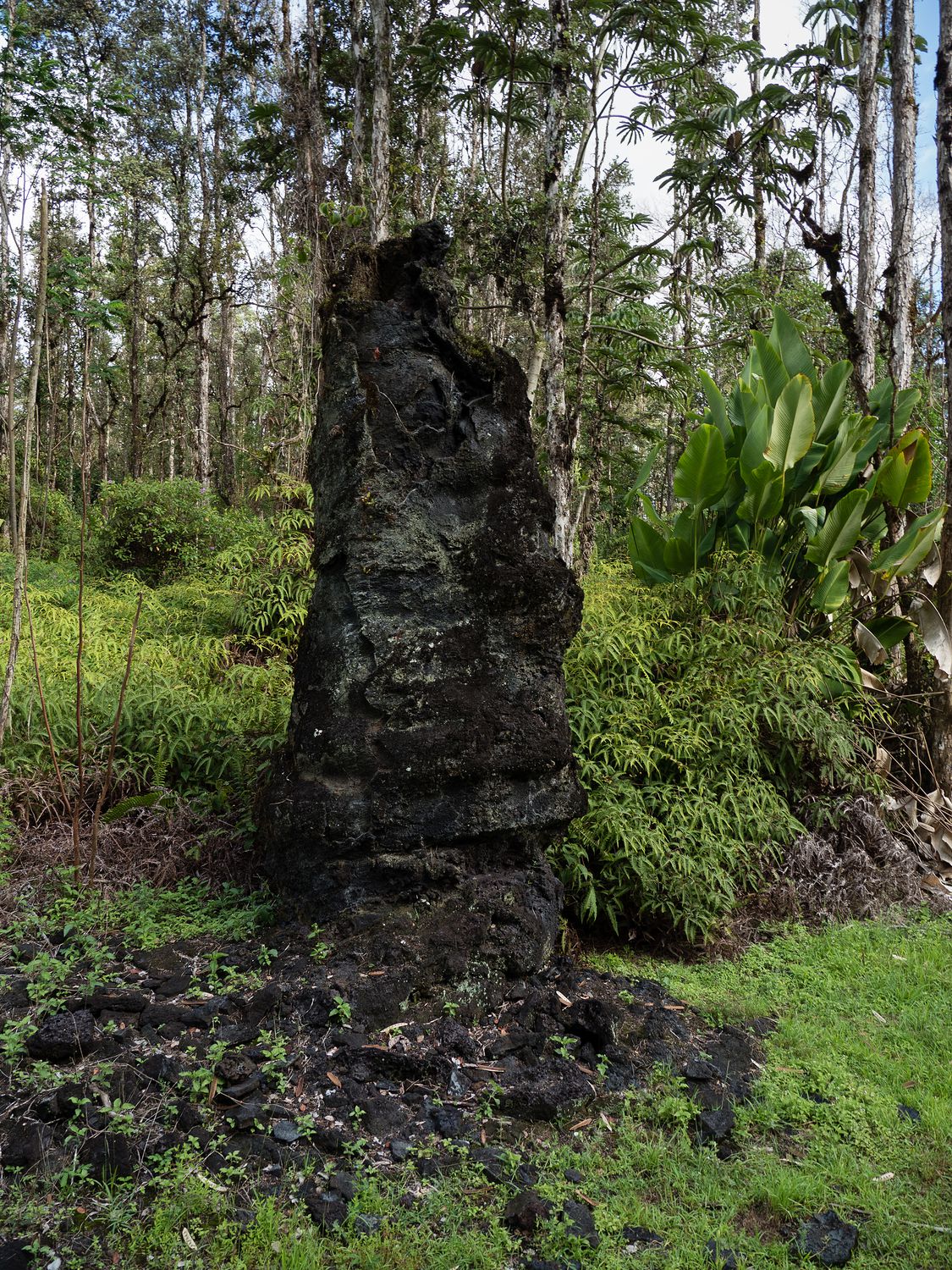
Our journey around this final triangle had us stopping at a few places along the coast to take some final photographs of Hawaii’s coastline before we started to head inland again. We also tried to stop by the area where you can see lava flowing into the ocean back out of Hawaii Volcanoes National Park, but it was too busy for us to get in, and we didn’t really have time to stay, as it was getting pretty late.
We had dinner at a little diner in a small town on our way back up to the main road. Mark had a grilled veggie sandwich and I had a grilled cheese. From dinner, it was about 40 minutes back to our hotel, and we rolled it once again just after 7pm.
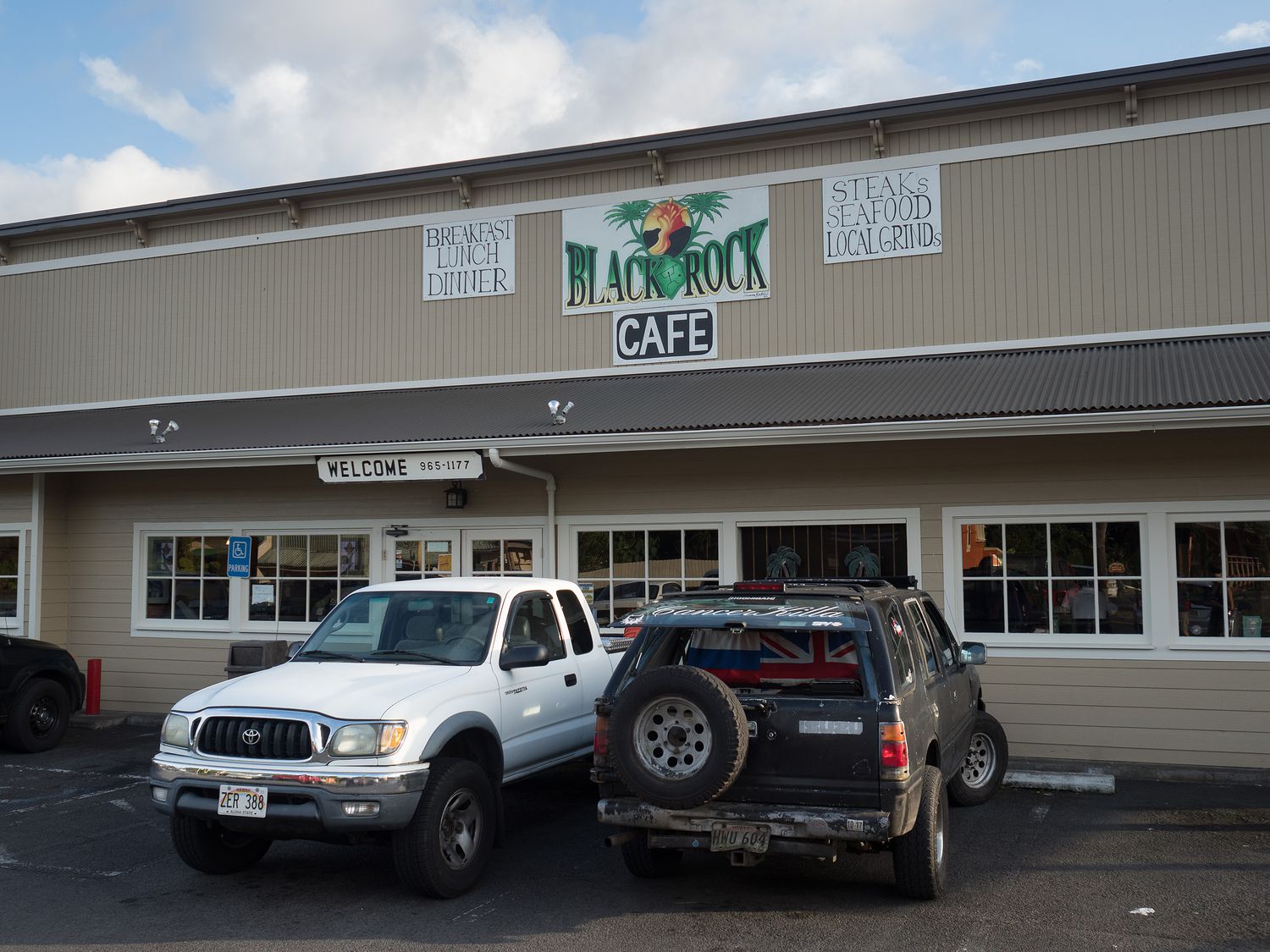
We’ve cleaned most of the mess out of our rental Jeep, and packed up the great majority of our belongings. We were originally planning to run tomorrow morning, but it is still raining here tonight, and I expect it to be the same in the morning, here in the rain forest. Our things got so wet this morning, and we can’t take them home like that, so we will just go ahead and skip it, even though it makes me sad.
We should be home at about 6am Thursday morning, the 27th, though we are leaving here about midmorning tomorrow, the 26th. Aren’t time changes lovely? Mark and I both have to go to work when we get back from the airport on Thursday. It should be a lovely day, since it is going to last for about 36 hours or so. I guess we will catch up on our sleep this weekend.
– Trip Total : 1,742 miles –
